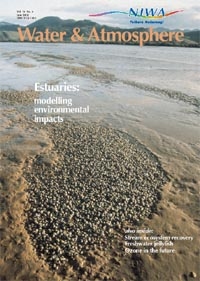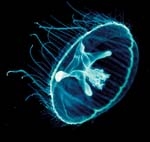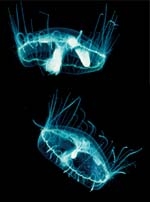PDF of this article (1 MB)

Ian Boothroyd Kay Etheredge John Green
Jellyfish are familiar marine animals, but they are also found in freshwater. One species is quite common in New Zealand.
Many people will have seen jellyfish washed up on the beaches around the New Zealand coastline following storms at sea. Some will be aware of the notorious “stingers” (box jellyfish – Chironex sp.) that make Northern Queensland beaches potentially lethal for swimming during December and January. There are also the infamous Portuguese man-of-war jellyfish colonies, occasionally seen on our beaches, but better known for their treacherous presence in the warm waters of the world. All of these are marine creatures. It may come as a surprise, therefore, to know that many lakes in New Zealand are home to a freshwater jellyfish. But before you think twice about a summer dip in a local lake – don’t worry. These jellyfish are harmless to humans and large animals, and feed only on small zooplankton species.
Life in two forms
The freshwater jellyfish, Craspedacusta sowerbyi, belongs to the Phylum Cnidaria, in the Limnomedusae, a group of hydrozoan jellyfish (see Jellyfish relationships). Hydrozoans have small solitary or colonial polyps and free-living medusae. Polyps are typically cylindrical or tube-like with mouth and tentacles at one end, usually directed upwards. The other end is attached to a substrate. The medusa stage is the classical jellyfish form, with an umbrella-like body. The concave or underside of the umbrella faces downwards with the mouth at the centre and tentacles hanging down from the rim.
Where did the freshwater jellyfish come from?



Medusae of Craspedacusta sowerbyi were first discovered in a tank at Kew Gardens, London, in 1880, where the huge Brazilian water lily Victoria amazonia was kept. How and when the medusae were introduced into the tanks was difficult to trace since no new plants had been added. It was concluded that the jellyfish was a tropical species, because of its presence in warm waters, and because it was first found in association with tropical South American plants.
Recent evidence suggests that C. sowerbyi originated from the Yang-tse-kiang region of China. An Asian origin is now generally agreed by scientists and today C. sowerbyi has a worldwide distribution.
C. sowerbyi in New Zealand
Medusae of C. sowerbyi were first recorded in New Zealand in Lake Taupo and numerous Rotorua lakes by V.H. Jolly during her survey of zooplankton in the North Island in the 1950s. It was first described in the New Zealand literature from Lake Maraetai (Waikato) in 1971, and there have been sporadic records and collections from all over mainland New Zealand.
C. sowerbyi occurs in lakes, including large hydroelectric impounded lakes on the Waikato River, throughout the upper North Island, as well as in Hawke’s Bay (Lake Tutira). C. sowerbyi has also been recorded as far south as Lake Brunner, on the west coast of the South Island, and in Lake Waiola near Dunedin. Other records include lakes Ruatuna, Mangakaware, Mangahia, Kainui and Rotomanuka (Waikato) and Nihotupu Resevoir (Auckland).
Male-only area!
The life cycle of C. sowerbyi includes both a polyp and medusa stage. The polyp may be solitary or may produce small colonies of a few attached individuals by budding. The active medusae also bud off from the sides of the polyps. Their production is thought to be related to water temperature, with medusae forming only in summer when water temperatures reach about 25°C. The medusa stage of hydrozoans is the sexually reproducing stage. The sexes are separate. Four gonads hang down from the underside of the umbrella. Medusae mature in a few days and congregate as swarms in the surface waters. Eggs and sperm are released into the water and fertilisation is external. The fertilised egg develops into a small larva that eventually settles on the lake bottom and develops into a polyp.
However, it seems that sexual reproduction can be a frustrating exercise for Craspedacusta. Only male jellyfish have ever been recorded in New Zealand, as well as in many other parts of the world. This means that the jellyfish must rely on budding polyps and perhaps accidental transport by humans (attached to weed or boats) to extend their range.
Food preferences
C. sowerbyi eats common zooplankton. They seem to particularly select Ceriodaphnia, a common crustacean. Other small animals seem to be eaten in proportion to their abundance. Very tiny zooplankton such as nauplii (baby crusctacea) and other rotifers may be too small and are missed by the tentacles, or perhaps are caught and digested too quickly to detect.
The preference for Ceriodaphnia is surprising since medusae of C. sowerbyi usually swim upward and then coast down with their tentacles spread out like a net, which will catch anything that happens to be in the way. The medusae possibly aggregate in places where densities of Ceriodaphnia are higher. Another possibility is that Ceriodaphnia is attracted towards the medusae, perhaps by chemical stimuli.
Does Craspedacusta predation affect lake communities?
We investigated the effect of Craspedacusta feeding on zooplankton in Lake Kainui, a small peat lake in the Waikato. To get an idea of the proportion of prey animals eaten we examined jellyfish gut contents, and also estimated how many medusae were feeding.
We found that the medusae ate only small proportions of their prey items – generally below 0.5% of the prey population per day. The only substantial effect was on Ceriodaphnia for which the daily value was 3.4%, assuming a 7-day lifespan. Even in relatively long-lived zooplankton, such as the crustaceans, Calamoecia lucasi and cyclopoid copepods, Craspedacusta predation would eat only 3–4% of the population. It seems unlikely therefore that jellyfish predation was a significant part of zooplankton mortality in Lake Kainui. However, our data were from only one sampling occasion and this conclusion needs more rigorous testing in other lakes.
A threat to New Zealand biodiversity?
Craspedacusta is found in lakes and waterbodies throughout New Zealand, and feeds on small zooplankton. The medusae usually occur only in summer as lake water warms. Although they are active predators, with a possible preference for specific prey, it seems unlikely that this jellyfish is a threat to the freshwater fauna of New Zealand. However, its influence on the feeding behaviour and food availability for other native zooplankton feeders, such as small pelagic fish, is unknown.
Teachers: this article can be used for Science Living World L5 A.O. 2. See other curriculum connections at www.niwa.co.nz/pubs/wa/resources
Ian Boothroyd was formerly based at NIWA Hamilton and now works for Kingett Mitchell Ltd, Auckland; John Green is Associate Professor at the University of Waikato; and Kay Etheredge lives at Te Pahu, Pirongia.
Jellyfish relationships
Jellyfish belong to the Phylum Cnidaria (previously known as Coelenterata). The phylum is characterised by possessing stinging cells, called cnidocytes or nematocysts, and often having life cycles with hydroid and medusa stages. There are four classes of Cnidaria.
Anthozoa: the true corals and sea anemones (see Water & Atmosphere 5(1): 6-7); these have no medusa stage.
Scyphozoa: the true jellyfish; 8-point symmetry, and a jelly layer – the mesoglea – lying between the two basic cell layers in the convex part of the medusa.
Hydrozoa: includes hydras, some corals and many small jellyfish (e.g., Craspedacusta); often colonial in the polyp stages, e.g., large colonial Portuguese man-of-war, Physalia.
Cubozoa: the box jellyfish, including Chironex – "stinger" jellyfish; 4-point symmetry, complex eyes and a characteristic type of polyp.
